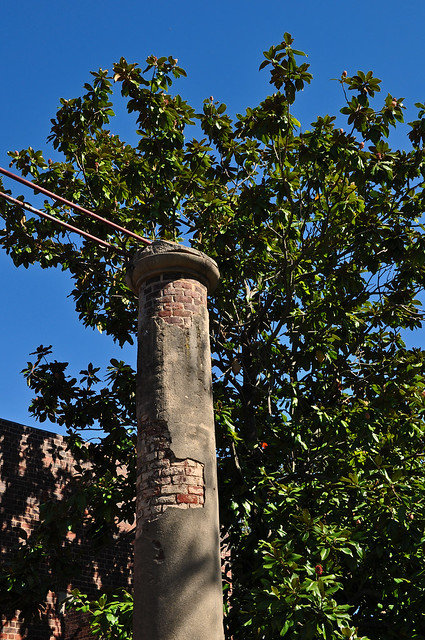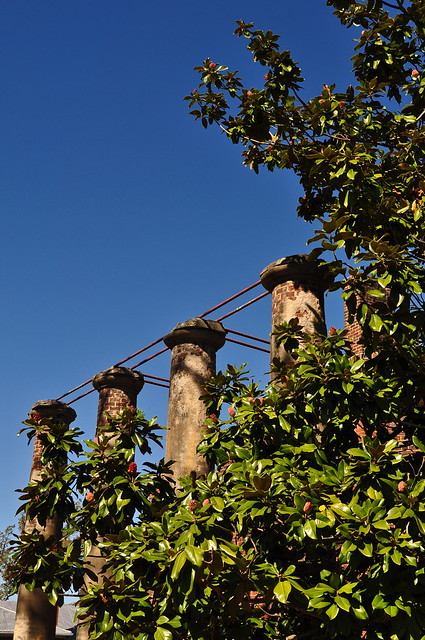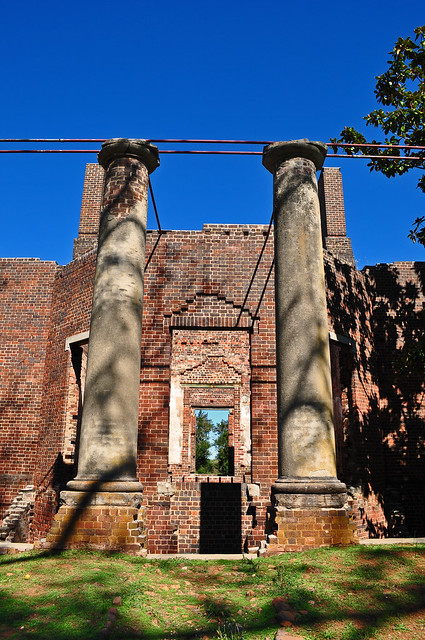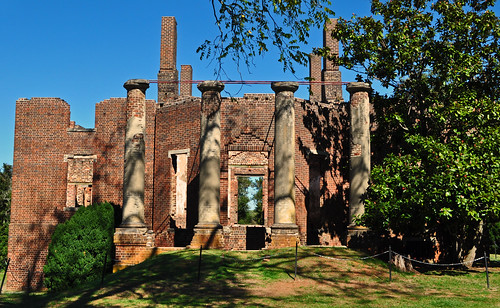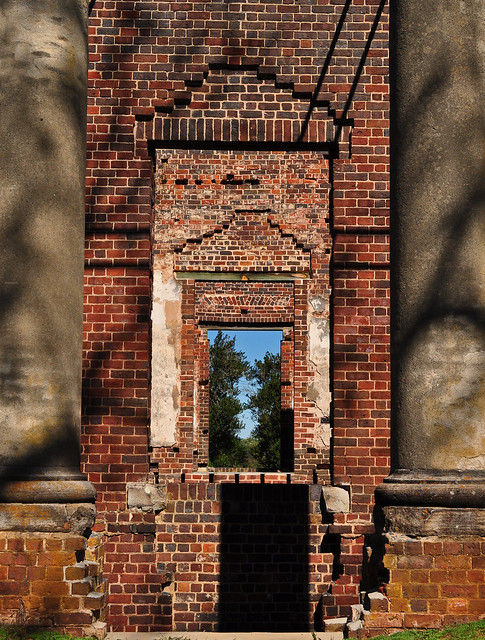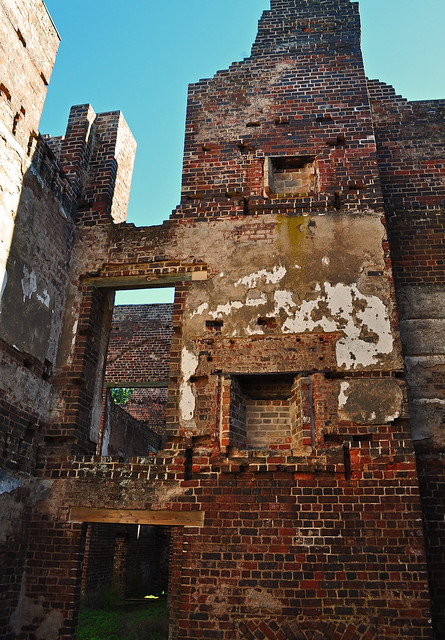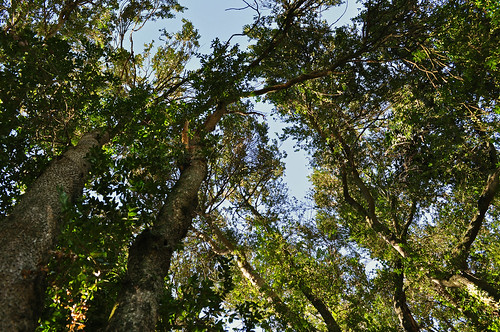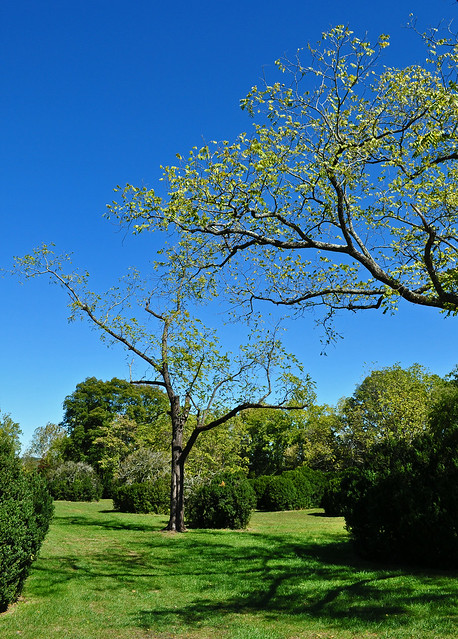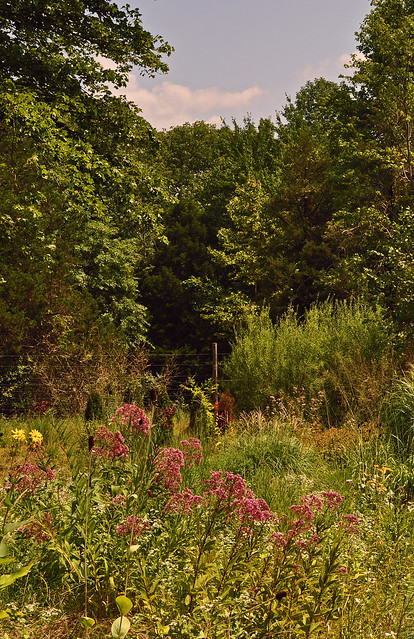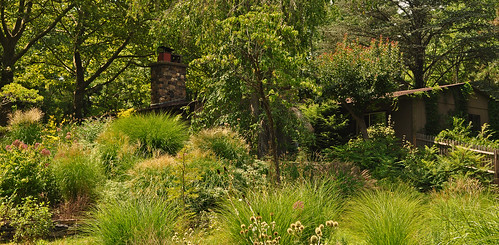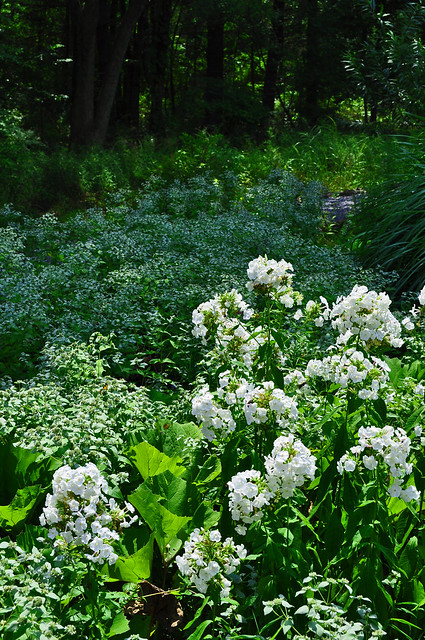This past Friday my son and I headed west for a weekend of camping. Along the way we travelled through one of my favorite parts of the state, the western Piedmont where it nears the Blue Ridge, and stopped at the Barboursville Ruins. The house was one of only a few that Thomas Jefferson designed for a friend, in this case James Barbour, who was a U.S. Senator, Secretary of War and a Governor of Virginia. It took 11 years to build and was constructed in Jefferson's favorite neo-Palladian style. The main receiving room was an octagon from which all other rooms flared. On Christmas Day in 1884 the house burned leaving nothing but the walls and porch columns. The love of Virginians for their history seems to know no age, and even back then the ruins were preserved. Today Barboursville is a central part of the Barboursville Vineyards, home of many excellent wines.
Along with the bricks, the historic landscape around Barboursville survived the fire as well. In order for Barbour's guests to get to the front door, they first had to traverse his race track still in place (this was and remains a country of serious horse culture). The other major feature of the landscape is its boxwood plantings. As I have said in several other posts, no old Virginia house, ruined or otherwise, can be without its boxwood. Those at Barboursville are the largest I have ever seen, and I was able to walk under them without hitting my head. If the house was still habitable, the race track would be obscured from the second floor rooms by boxwood.
(My usual disclaimer is in place, in that I have not received any compensation for the mention of anything in this post, including a case of 2006 Octagon which would not be refused if it should happen to appear on my doorstep.)
October 11, 2010
October 5, 2010
A Real Garden
Recently fellow blogger James at View From Federal Twist wrote a post where he relayed an overheard comment about his garden. Seems a house guest did not think his garden was a real one, perhaps preferring something with more formality or tradition. Regardless, this created an excellent opportunity to discuss just what qualifies as a garden. Do a few plants in pots on a balcony constitute a garden? How about a prairie set on fire to encourage some plants at the detriment of others? What about a patch of cosmos and daylilies planted by the highway department or a Zen garden of raked sand? In my own neighborhood should wetland restoration with native plantings count? In my mind, all of these qualify as gardening, but to others, perhaps not.
This summer I had the chance to see James' garden for myself as my family, my brother and I descended upon him on the last day of our vacation. His home and garden are set among the woods in western New Jersey (necessarily surrounded by deer fencing). Though some gardening takes place out front, most of what James has accomplished is on the other side of the house. The garden's look could best be termed "new American" or "bold romantic" in the style of Piet Oudolf or Van Sweden and Oehme, but is actually more James Golden than James van Sweden. The garden has large drifts of grasses, punctuated by naturalistic plantings of perennials, shrubs and trees. Linking the different areas of the garden and house is a pleasant gravel pathway, as well as a terrace which has a commanding view of the creation. The whole garden appears as if it arose naturally from the surrounding landscape, fitting in seamlessly with the architecture of the house. It is indeed a real garden.
The day we were there was not a good day to be outside. It was hot and humid even by southern standards, and the harsh afternoon light made for poor photos. But what the weather took away from the day, circumstance gave back. Perhaps the focal point of James' garden is a sculpture created by Marc Rosenquist, and we were fortunate enough to be there while he and his wife Gail were visiting too. After a leisurely garden tour, we spent a little time in the AC with a glass of wine and conversation - it was a great way to spend our last full day in the north country.
Thank you James and Phil
This summer I had the chance to see James' garden for myself as my family, my brother and I descended upon him on the last day of our vacation. His home and garden are set among the woods in western New Jersey (necessarily surrounded by deer fencing). Though some gardening takes place out front, most of what James has accomplished is on the other side of the house. The garden's look could best be termed "new American" or "bold romantic" in the style of Piet Oudolf or Van Sweden and Oehme, but is actually more James Golden than James van Sweden. The garden has large drifts of grasses, punctuated by naturalistic plantings of perennials, shrubs and trees. Linking the different areas of the garden and house is a pleasant gravel pathway, as well as a terrace which has a commanding view of the creation. The whole garden appears as if it arose naturally from the surrounding landscape, fitting in seamlessly with the architecture of the house. It is indeed a real garden.
The day we were there was not a good day to be outside. It was hot and humid even by southern standards, and the harsh afternoon light made for poor photos. But what the weather took away from the day, circumstance gave back. Perhaps the focal point of James' garden is a sculpture created by Marc Rosenquist, and we were fortunate enough to be there while he and his wife Gail were visiting too. After a leisurely garden tour, we spent a little time in the AC with a glass of wine and conversation - it was a great way to spend our last full day in the north country.
Thank you James and Phil
Subscribe to:
Posts (Atom)
